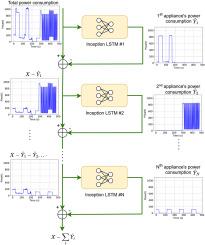Neural Network-Aided NILM (NNAN) disaggregation: Revealing appliance consumption patterns with iterative subtraction
IF 4.9
引用次数: 0
Abstract
Non-Intrusive Load Monitoring (NILM) is a method to decompose overall electricity consumption into individual appliance-level data, utilizing the primary meter’s readings without additional sensors on each device. This article introduces a novel approach which is a Neural Network-Aided NILM (NNAN), focusing on revealing appliance consumption patterns by following a sequential subtraction method. Our goal is to tackle the issue where high-power and highly-used appliances make it difficult for neural networks to accurately separate the usage of lower-power and less-used appliances. We mainly employ Long Short-Term Memory (LSTM) and Convolutional Neural Networks (CNN) using inception blocks as key components. Our proposed architecture is validated on three public datasets that are AMPds2, ECO and UK-DALE. The NNAN model showed promising results, achieving disaggregation accuracy improvements of up to 5.13% on AMPds2, 3.79% on ECO, and 9.55% on UK-DALE compared to the reference methods. Additionally, NNAN reduces model complexity, requiring up to 74% fewer parameters than traditional deep learning approaches, leading to improved computational efficiency. Finally, NNAN demonstrated a reduced correlation between appliance usage rates and disaggregation accuracies.

神经网络辅助NILM (NNAN)分解:用迭代减法揭示家电消费模式
非侵入式负荷监测(NILM)是一种将总用电量分解为单个电器级数据的方法,利用主电表的读数,而无需在每个设备上附加传感器。本文介绍了一种新的方法,即神经网络辅助NILM (NNAN),重点是通过遵循顺序减法来揭示设备的消费模式。我们的目标是解决高功耗和高使用率电器使神经网络难以准确区分低功耗和低功耗电器使用情况的问题。我们主要采用长短期记忆(LSTM)和卷积神经网络(CNN),并使用初始块作为关键组件。我们提出的架构在三个公共数据集(AMPds2, ECO和UK-DALE)上进行了验证。与参考方法相比,NNAN模型在AMPds2上的分解准确率提高了5.13%,在ECO上提高了3.79%,在UK-DALE上提高了9.55%。此外,NNAN降低了模型复杂性,与传统深度学习方法相比,需要的参数减少了74%,从而提高了计算效率。最后,NNAN证明了设备使用率和分解准确率之间的相关性降低。
本文章由计算机程序翻译,如有差异,请以英文原文为准。
求助全文
约1分钟内获得全文
求助全文
来源期刊

Machine learning with applications
Management Science and Operations Research, Artificial Intelligence, Computer Science Applications
自引率
0.00%
发文量
0
审稿时长
98 days
 求助内容:
求助内容: 应助结果提醒方式:
应助结果提醒方式:


